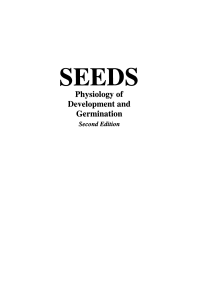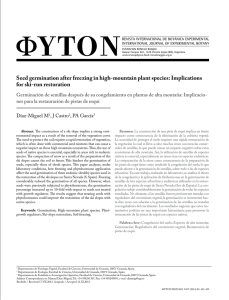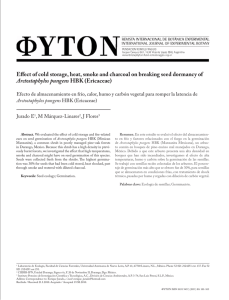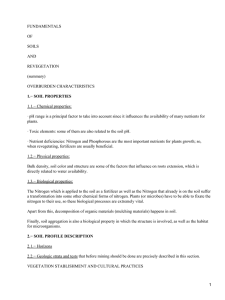Effect of seed burial in different soils on the germination of three
Anuncio
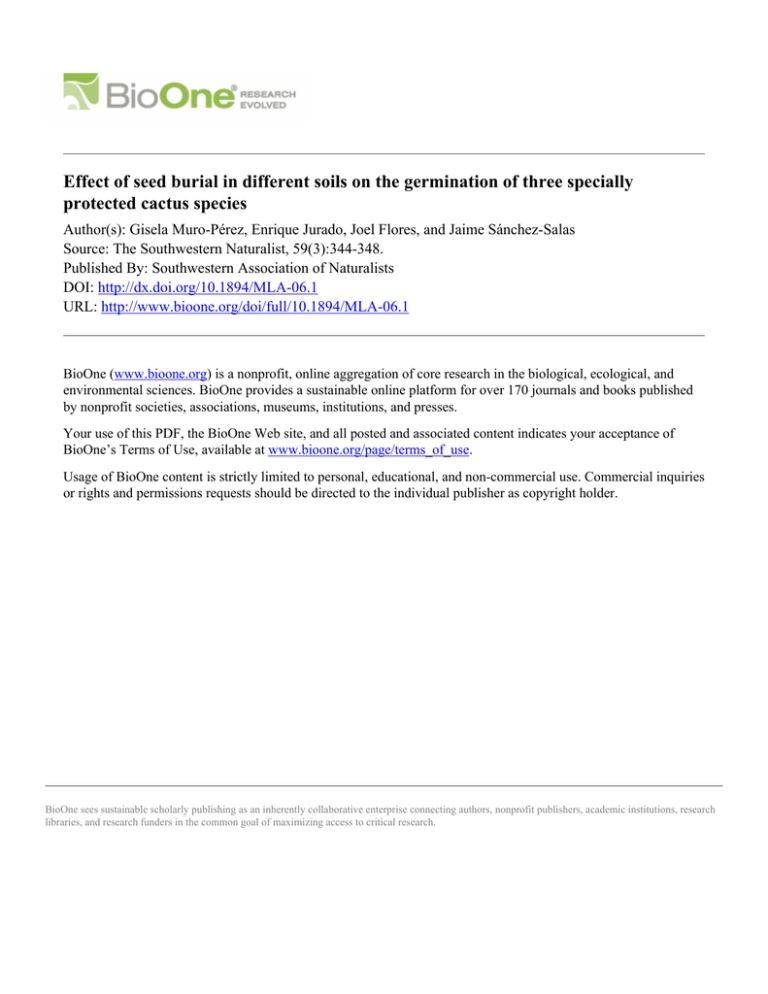
Effect of seed burial in different soils on the germination of three specially protected cactus species Author(s): Gisela Muro-Pérez, Enrique Jurado, Joel Flores, and Jaime Sánchez-Salas Source: The Southwestern Naturalist, 59(3):344-348. Published By: Southwestern Association of Naturalists DOI: http://dx.doi.org/10.1894/MLA-06.1 URL: http://www.bioone.org/doi/full/10.1894/MLA-06.1 BioOne (www.bioone.org) is a nonprofit, online aggregation of core research in the biological, ecological, and environmental sciences. BioOne provides a sustainable online platform for over 170 journals and books published by nonprofit societies, associations, museums, institutions, and presses. Your use of this PDF, the BioOne Web site, and all posted and associated content indicates your acceptance of BioOne’s Terms of Use, available at www.bioone.org/page/terms_of_use. Usage of BioOne content is strictly limited to personal, educational, and non-commercial use. Commercial inquiries or rights and permissions requests should be directed to the individual publisher as copyright holder. BioOne sees sustainable scholarly publishing as an inherently collaborative enterprise connecting authors, nonprofit publishers, academic institutions, research libraries, and research funders in the common goal of maximizing access to critical research. THE SOUTHWESTERN NATURALIST 59(3): 344–348 SEPTEMBER 2014 EFFECT OF SEED BURIAL IN DIFFERENT SOILS ON THE GERMINATION OF THREE SPECIALLY PROTECTED CACTUS SPECIES GISELA MURO-PÉREZ, ENRIQUE JURADO,* JOEL FLORES, AND JAIME SÁNCHEZ-SALAS Facultad de Ciencias Forestales, Universidad Autónoma de Nuevo León, A.P. 41. Carretera Nacional km. 145, Linares, N.L. 67700, México (GM, EJ, JS) Instituto Potosino de Investigación Cientı́fica y Tecnológica, A.C., División de Ciencias Ambientales. Camino a la Presa San José No. 2055, Lomas 4ª Sección, San Luis Potosı́, 78216, S.L.P., México (JF) Facultad de Ciencias Biológicas-UJED, Av. Universidad s/n, Fracc. Filadelfia, Gómez Palacio 35010, Dgo., México (JS) *Correspondent: [email protected] ABSTRACT—Seedling establishment of many cactus species appears to be more frequent under canopies of nurse plants, which provide a less stressful microenvironment. Under these nurse plants, nutrient levels in the soil could be higher than in surrounding areas; these higher nutrient levels could promote higher seed germination. Seed burial under nurse plants may occur by seeds falling in the litter or in soil cracks; however, buried seeds are in the dark, which has been shown to inhibit seed germination for some cactus species. We measured germination percentage on nutrient-rich soil from under nurse mesquites and in soil from open spaces, and the effect of seed burial (buried and unburied seeds) on seed germination of three cactus species (Coryphantha durangensis, Peniocereus greggii, and Echinocereus longisetus) that grow under nurse plants in the Chihuahuan Desert. Echinocereus longisetus had very low germination across substrates. Coryphantha durangensis had higher germination on mesquite soil than on poor soil, and its buried seeds had lower germination than seeds on the soil surface. Germination of P. greggii seeds was higher on mesquite soil than on poor soil, and its buried seeds had lower germination than seeds on the soil surface. RESUMEN—El establecimiento de muchas especies de cactus parece ser más frecuente bajo la copa de plantas nodriza, la cual provee un microambiente menos estresante. Bajo estas plantas nodrizas, los niveles de nutrientes en el suelo podrı́an ser más altos que en los alrededores, ası́ que estos nutrientes podrı́an promover la germinación más alta de semillas. Bajo plantas nodriza puede ocurrir enterramiento de semillas, ya que las semillas caen en la hojarasca o en las grietas del suelo; sin embargo, las semillas enterradas están en la oscuridad, y se ha encontrado que esta condición inhibe la germinación de semillas de algunas especies de cactus. Se evaluó el porcentaje de germinación en suelo rico en nutrientes bajo mezquites nodrizos y en suelo de espacios abiertos y el efecto del enterramiento de las semillas (enterradas y no enterradas) en la germinación de semillas de tres especies de cactus (Coryphantha durangensis, Peniocereus greggii y Echinocereus longisetus) que crecen bajo plantas nodriza en el desierto Chihuahuense. Echinocereus longisetus tuvo muy baja germinación en ambos tipos de suelo. Coryphantha durangensis presentó mayor germinación en suelo de mezquite que en suelo pobre, y sus semillas enterradas tuvieron menor germinación que las de la superficie del suelo. La germinación de P. greggii fue más alta en suelo de mesquite que en suelo pobre, y sus semillas enterradas tuvieron menor germinación que las semillas que estuvieron en la superficie del suelo. Favorable conditions for recruitment in arid systems are rare because of prevailing harsh conditions (Flores and Jurado, 2003; Zhang et al., 2011). Seedling establishment of many species appears to be more frequent under canopies of adult plants of other species that provide a less stressful microenvironment (Ellner and Shmida, 1981). This association of emergent seedlings and adult plants has been called ‘‘nurse plant syndrome’’ (Niering et al., 1963) or ‘‘nurse–protégé’’ interaction (Cody, 1993; Flores and Jurado, 2003). The causes of nurse–seedling relationships can vary between species and environments, and it is possible that multiple causes account for this association (Flores and Jurado, 2003). For example, a larger number of seeds can be recruited under shrubs compared with bare soil (seed trapping); more water is available under established shrubs than on bare soil (moisture safe site); more nutrients are available in the soil under established shrubs than under surrounding soil (nutrient safe site); greater protection of protégé species from grazing and trampling is available under shrubs (safe site from herbivores), or greater physical support for protégé species is available, at least in the early stages of their life cycle (physical support safe site). September 2014 Muro-Pérez et al.—Seed burial effect on cactus germination Nutrient levels in the soil could be higher under the canopies of established shrubs than in surrounding soil as a result of nutrient concentration from vertical and horizontal root uptake, accumulation of litter, increased bird and insect droppings, and, in some cases, nitrogen fixation (Flores and Jurado, 2003). These higher nutrient levels in the soil could promote higher seed germination (Godı́nez-Álvarez and Valiente-Banuet, 1998; Baskin and Baskin, 2001). Many cactus species grow under nurse plants (Flores and Jurado, 2003). Soil characteristics have been found to affect seed germination of several cacti, like Carnegiea gigantea and Stenocereus thurberi (McDonough, 1964), Ferocactus histrix (Del Castillo, 1986), Mammillaria heyderi (Trejo-Hernández and Garza-Castillo, 1993), Turbinicarpus polaskii, T. schwarzii, and Echinocereus morricallii (Jolly and Lockert, 1996). The soil under mesquite plants has been found to have more organic matter and nutrients than soil from open areas (Muro-Pérez et al., 2012); however, there are no studies evaluating whether the soil under nurse plants, likely to have more nutrients, results in higher seed germination than soil from open spaces. Nutrients in the soil are important for germination of some species (i.e., biological soil crusts) that have higher nutrients than soils without them, and have a positive effect on the seed germination of the cactus Myrtillocactus geometrizans (Rivera-Aguilar et al., 2005). Another factor influencing germination and seedling emergence is the depth of seed burial in the soil (Fuchs et al., 2000; Traba et al., 2004; Flores-Cano et al., 2012). Seed burial may be promoted by abiotic-driven soil disturbances, such as those caused by water and wind, as well as by biotic factors, including the foraging behavior of seed dispersers and earthworm activity (Vander-Wall 1990, 1993; Chambers and MacMahon, 1994; Renard et al., 2010). Seed burial helps seeds escape from postdispersal predation and prevents death of the embryo by desiccation or exposure to extreme temperatures during an unfavorable season (Borchert et al., 1989; Vander-Wall, 1990; Seiwa et al., 2002; Cheng et al., 2007). Burial may occur by seeds falling in the litter or in soil cracks, and is important for germination, because it may provide benefits such as reduction of air exposure, maintenance of high humidity levels, and protection against extreme temperatures and foraging granivores (Everitt, 1983; Seiwa et al., 2002; Li et al., 2012). However, buried seeds are in the dark, which has been shown to inhibit seed germination for some cactus species (Benı́tez-Rodrı́guez et al., 2004; Flores et al., 2006, 2011). We evaluated germination percentage on nutrient-rich soil under nurse plants and poor soil from open spaces, and the effect of seed burial (buried and unburied seeds) on seed germination of three cactus species: Coryphantha durangensis, Peniocereus greggii, and E. longisetus, that grow under nurse plants (Muro-Pérez et al., 2012). The three 345 studied species are under special protection status (Hunt, 1992; SEMARNAT, 2010). MATERIALS AND METHODS—Study Area and Studied Species— Coryphantha durangnesis, P. greggii, and E. longisetus are distributed in a canyon in Cañón de Fernández State Park (25827 0 N, 103846 0 W) within the Chihuahuan Desert in México at an elevation of 1,200 m above sea level. Temperature ranges from 1.68C (in January) to 37.48C (in June), with an annual rainfall of 200–350 mm. The main plant communities are thornscrub dominated by either small-leaved, rosette, or hemisucculent and succulent plants (Muro-Pérez et al., 2012). Coryphantha durangensis grows 10–15 cm high and 4–6 cm wide as isolated individuals or in small clumps (Bravo-Hollis, 1978; Bravo-Hollis and Sánchez-Mejorada, 1989). Echinocereus longisetus is cylindrical, 15–30 cm high and 5–7 cm wide (Bravo-Hollis and Sánchez-Mejorada, 1989). Peniocereus greggii has an erect curved stem 20–60 cm high and 3 cm in diameter (Bravo-Hollis and Sánchez-Mejorada, 1989). Area of Species Distribution—Coryphantha durangensis grows in Coahuila and Durango, México; P. greggii is distributed in Chihuahua, Coahuila, Durango, Nuevo León, Sonora, and Zacatecas, México (Guzmán et al., 2003) as well as in Texas, New Mexico, and Arizona, USA (Sánchez-Salas et al., 2009). Echinocereus longisetus is found in Coahuila and Nuevo León (Guzmán et al., 2003). Seeds from these species were collected in the Cañón de Fernández, an area with high cactus richness in the southern Chihuahuan Desert (Valencia-Castro, 2005). Seed Collection—Fruits from the three cactus species were collected in April 2009 at Cañón de Fernández State Park from at least 10 mother plants. Fruits were placed in paper bags and set to dry at room temperature for a month to prevent any moisture development that might prompt germination or decomposition (Moreno et al., 1992). Experimental Design—Germination was recorded daily for 1 month as the emergence of the radicle or any part of the embryo, as recommended for arid-zone plants (Baskin and Baskin, 2001). The experimental design was complete random factorial 3 · 4 · 5. There were 20 seeds per plot and five plots per line, with a total of 100 seeds per treatment. There were four treatments: 1) seeds placed on mesquite soil, 2) seeds placed on poor soil, 3) seeds buried at 0.5 cm under mesquite soil, and 4) seeds buried 0.5 cm under poor soil. Statistical Analyses—Treatment and species were used as factors for the analysis of variance. Percentage germination data were arcsine transformed before analysis to comply with analysis of variance requirements. RESULTS AND DISCUSSION—Previous studies have shown that nutrient levels in the soil are higher under the canopies of established shrubs than in the surrounding soil (Flores and Jurado, 2003; Muro-Pérez et al., 2012). We hypothesized that higher nutrient levels in the soil could promote higher seed germination (Godı́nezÁlvarez and Valiente-Banuet, 1998; Baskin and Baskin, 2001). Echinocereus longisetus had very low germination (4% – 1.2%) across substrates, and there were no significant differences among treatments (F = 2.66; P = 0.08). Coryphanta durangensis (Fig. 1) had higher germination on mesquite soil (96% – 0.024%) than on poor 346 vol. 59, no. 3 The Southwestern Naturalist FIG. 1—Germination of Coryphanta durangensis. Different lowercase letters represent differences between means (a = 0.05). soil (56% – 0.605%; F = 21.09, P < 0.0001). A similar result was found for P. greggii seeds (Fig. 2), which had higher germination on mesquite soil (85% – 0.076%) than on poor soil (69% – 0.55%; F = 7.67, P < 0.0001). The results for these two species are in agreement with the proposed hypothesis, in that more seeds of C. durangensis and P. greggii germinated on mesquite soil than on poor soil. For these species, germination on poor soil was also high; suggesting that seed distribution and seedling establishment may differ under both conditions for other reasons besides soil quality, such as hydraulic uplift or protection from trampling (Flores and Jurado, 2003). These results should be considered in conservation programs for these protected species. We also hypothesized that cactus seeds would not germinate when buried, because they would be in total darkness and require light to germinate (Flores et al., 2006, 2011). Accordingly, we found very low germination for buried seeds of C. durangensis (Fig. 1) and P. greggii (Fig. 2). Coryphantha durangensis buried seeds had lower germination (2% for seeds buried in mesquite soil and no germination for seeds buried in poor soil) than seeds on the soil surface (F = 21.09, P < 0.0001). Germination of P. greggii buried seeds had lower germination (F = 7.67, P < 0.0001) than seeds on the soil surface (6% – 0.604% under mesquite soil and 8% – 0.152% under poor soil). Most cactus seeds need light to germinate (Flores et al., 2011); hence it is possible that ungerminated buried seeds in our study were dormant, because burial is an essential prelude to dormancy in several species (Thompson et al., 1993; Grime, 2001). Burial may also provide safe sites from harsh conditions for seeds until germination occurs, although other processes such as seed predation and fungal attack could also be operating FIG. 2—Germination of Peniocereus greggii. Different lowercase letters represent differences between means (a = 0.05). (Borchert et al., 1989; Vander-Wall, 1993; Seiwa et al., 2002). Seeds of E. longisetus appear to exhibit seed dormancy even under light conditions. In arid and semiarid environments, seed germination and seedling establishment are infrequent because of extreme temperatures and low water availability (Flores and Jurado, 2003; Flores et al., 2004). Thus, a common plant strategy in these environments is seed dormancy, which is found in several plant families (Baskin and Baskin, 2001; Jurado and Moles, 2003; including Cactaceae (Rojas-Aréchiga and Vázquez-Yanes, 2000; Flores et al., 2005, 2006, 2008, 2011). CONCLUSIONS—Echinocereus longisetus had very low germination across substrates. Seeds of C. durangensis and P. greggii had higher germination on soil from under nurse mesquites than on poor soil. Buried seeds of both species had lower germination than seeds on the soil surface. LITERATURE CITED BASKIN, C., AND J. M. BASKIN. 2001. Seeds: ecology, biogeography, and evolution of dormancy and germination. Academic Press, San Diego, California. BENÍTEZ-RODRÍGUEZ, J. L., A. OROZCO-SEGOVIA, AND M. ROJASARÉCHIGA. 2004. Light effect on seed germination of four Mammillaria species from the Tehuacán-Cuicatlán Valley, central Mexico. Southwestern Naturalist 49:11–17. BORCHERT, M. I., F. W. DAVIS, J. MICHAELSEN, AND L. D. OYLER. 1989. Interactions of factors affecting seedling recruitment of blue oak (Quercus douglasii) in California. Ecology 70:389–404. BRAVO-HOLLIS, H. 1978. Las cactaceas de Mexico. Volume I. September 2014 Muro-Pérez et al.—Seed burial effect on cactus germination Universidad Nacional Autonoma de Mexico, Mexico City, Mexico. BRAVO-HOLLIS, H. AND H. SANCHEZ-MEJORADA. 1989. Las cactaceas de Mexico. Volume II. Universidad Nacional Autonoma de Mexico, Mexico City, Mexico. CHAMBERS, J. C., AND J. A. MACMAHON. 1994. A day in the life of a seed: movements and fates of seeds and their implications for natural and managed systems. Annual Review of Ecology and Systematics 25:263–292. CHENG, J. R., Z. S. XIAO, AND Z. B. ZHANG. 2007. Effects of burial and coating on acorn survival of Quercus variabilis and Quercus serrata under rodent predation. Chinese Journal of Ecology 26:668–672. CODY, M. L. 1993. Do cholla cacti (Opuntia spp., Subgenus Cylindropuntia) use or need nurse plants in the Mojave Desert? Journal of Arid Environments 24:139–154. DEL CASTILLO, R. 1986. Semillas, germinación y establecimiento de Ferocactus histrix. Cactáceas y Suculentas Mexicanas 31:5– 11. ELLNER, S., AND A. SCHMIDA. 1981. Why are adaptations for longrange seed dispersal rare in desert plants? Oecologia 51:133– 144. EVERITT, J. H. 1983. Germination of mescal bean (Sophora secundiflora) seeds. Southwestern Naturalist 28:437–443. FLORES, J., AND E. JURADO. 2003. Are nurse-protégé interactions more common among plants from arid environments? Journal of Vegetation Science 14:911–916. FLORES, J., A. ARREDONDO, AND E. JURADO. 2005. Comparative seed germination in species of Turbinicarpus: an endangered cacti genus. Natural Areas Journal 25:183–187. FLORES, J., O. BRIONES, A. FLORES, AND S. SÁNCHEZ-COLÓN. 2004. Effect of predation and solar exposure on the emergence and survival of desert seedlings of contrasting life-forms. Journal of Arid Environments 58:1–18. FLORES, J., E. JURADO, AND A. ARREDONDO. 2006. Effect of light on germination of seeds of Cactaceae from the Chihuahuan Desert, México. Seed Science Research 16:149–155. FLORES, J., E. JURADO, L. CHAPA-VARGAS, A. CERONI-STUVA, P. DÁVILAARANDA, G. GALÍNDEZ, D. GURVICH, P. LEÓN-LOBOS, C. ORDÓÑEZ, P. ORTEGA-BAES, N. RAMÍREZ-BULLÓN, A. SANDOVAL, C. E. SEAL, T. ULIAN, AND H. W. PRITCHARD. 2011. Seeds photoblastism and its relationship with some plant traits in 136 cacti species. Environmental and Experimental Botany 71:79–88. FLORES, J., E. JURADO, AND J. F. JIMÉNEZ-BREMONT. 2008. Breaking seed dormancy in specially protected Turbinicarpus lophophoroides and Turbinicarpus pseudopectinatus (Cactaceae). Plant Species Biology 23:44–47. FLORES-CANO, J., E. I. BADANO, AND J. FLORES. 2012. Effects of burial depth on seed germination and seedling emergence of Mexican oaks: a glasshouse experiment. Archives of Biological Science, Belgrade 64:1543–1554. FUCHS, M. A., P. G. KRANNITZ, AND A. S. HARESTAD. 2000. Factors affecting emergence and first-year survival of seedlings of Garry oaks (Quercus garryana) in British Columbia, Canada. Forest, Ecology and Management 137:209–219. GODÍNEZ-ÁLVAREZ, H, AND A. VALIENTE-BANUET. 1998. Germination and early seedling growth of Tehuacán Valley cacti species: the role of soils and seed ingestion by dispersers on seedling growth. Journal of Arid Environments 39:21–31. GRIME, J. P. 2001. Plant strategies, vegetation processes, and ecosystem properties. John Wiley & Sons, Chichester, England. 347 GUZMÁN, U., S. ARIAS, AND P. DÁVILA. 2003. Catálogo de cactáceas mexicanas. Universidad Nacional Autónoma de México— Comisión Nacional para el Conocimiento y Uso de la Biodiversidad (CONABIO). México, D.F. HUNT, D. 1992. CITES Cactaceae checklist. Royal Botanic Gardens, Kew, England. JOLLY, J., AND X. LOCKERT. 1996. Sowing: germination and substrates. Cactus Aventures International 31:22–25. JURADO, E., AND A. T. MOLES. 2003. Germination deferment strategies. Pages 381–388 in The biology of seeds: recent research advances (Nicolás, G., K. J. Bradford, D. Côme, M. Curie, and H. W. Pritchard, editors). CABI Publishing, Wallingford, England. LI, X., D. M. JIANG, A. Q. QZHOU, AND T. OSHIDA. 2012. Comparison of seed germination of four Artemisia species (Asteraceae) in northeastern Inner Mongolia, China. Journal of Arid Land 4:36–42. MCDONOUGH, W. T. 1964. Germination responses of Carnegiea gigantea and Lemaireocereus thurberi. Ecology 45:155–159. MORENO, N., J. J. LÔPEZ, AND L. ARCE. 1992. Aspectos sobre la germinación de Echinomastus mariposensis Hester. Cactáceas y Suculentas Mexicanas 37:21–27. MURO-PÉREZ, G., E. JURADO, J. FLORES, J. SÁNCHEZ-SALAS, AND J. GARCÍA-PÉREZ. 2012. Positive effects of native shrubs on three specially protected cacti species in Durango, México. Plant Species Biology 27:53–58. NIERING, W. A., R. H. WHITTAKER, AND C. H. LOWE. 1963. The saguaro: a population in relation to environment. Science 142:15–23. RENARD, D., B. SCHATZ, AND D. B. MCKEY. 2010. Ant nest architecture and seed burial depth: implications for seed fate and germination success in a myrmecochorous savanna shrub. Ecoscience 17:194–202. RIVERA-AGUILAR, V., H. GODÍNEZ-ÁLVAREZ, I. MANUELL-CACHEUX, AND S. RODRÍGUEZ-ZARAGOZA. 2005. Physical effects of biological soil crusts on seed germination of two desert plants under laboratory conditions. Journal of Arid Environments 63:344– 352. ROJAS-ARÉCHIGA, M., AND C. VÁZQUEZ-YANES. 2000. Cactus seed germination: a review. Journal of Arid Environments 44:85– 104. SÁNCHEZ-SALAS, J., J. FLORES, G. MURO PÉREZ, AND C. MARTÍNEZ ADRIANO. 2009. El reinado desconocido de Peniocereus greggii. Boletı́n de la Sociedad Latinoamericana y del Caribe de Cactáceas y otras Suculentas 6:21–24. SEIWA, K., A. WATANABE, T. SAITOH, H. KANNO, AND S. AKASAKA. 2002. Effects of burying depth and seed size on seedling establishment of Japanese chestnuts, Castanea crenata. Forest Ecology and Management 164:149–156. SEMARNAT. 2010. NORMA Oficial Mexicana NOM-059-SEMARNAT-2010, Protección ambiental-Especies nativas de México de flora y fauna silvestres-Categorı́as de riesgo y especificaciones para su inclusión, exclusión o cambio-Lista de especies en riesgo. Secretaria de Medio Ambiente y Recursos Naturales. Diario Oficial de la Federación. México, D.F. THOMPSON, K., C. D. THOMAS, J. M. A. RADLEY, S. WILLIAMSON, AND J. H. LAWTON. 1993. The effect of earthworms and snails in a simple plant community. Oecologia 95:171–178. TRABA, J., F. M. AZCÁRATE, AND B. PECO. 2004. From what depth do seeds emerge? A soil seed bank experiment with 348 The Southwestern Naturalist Mediterranean grassland species. Seed Science Research 14:297–303. TREJO-HERNÁNDEZ, L., AND M. R. GARZA-CASTILLO. 1993. Efecto del tiempo de almacenamiento en la germinación de semillas de Mammillaria heyderi Muchl. en cuatro sustratos. Biotam 5:19– 24. VALENCIA-CASTRO, M. C. 2005. Conservación de ecosistemas naturales en la comarca lagunera. Revista Chapingo, Serie Zonas Áridas 4(2):1–8. VANDER-WALL, S. B. 1990. Food hoarding in animals. Chicago University Press, Chicago, Illinois. vol. 59, no. 3 VANDER-WALL, S. B. 1993. A model of caching depth: implications for scatter hoarders and plant dispersal. American Naturalist 141:217–232. ZHANG, D. Y., H. L. LIU, X. SHI, J. C. WANG, AND Y. K. ZHANG. 2011. Limitations on the recruitment of the rare sand shrubby legume Eremosparton songoricum (Fabaceae) in Gurbantunggut Desert, China. Journal of Arid Land 3:75–84. Submitted 8 November 2012. Acceptance recommended by Associate Editor, Mara L. Alexander, 22 October 2013.
